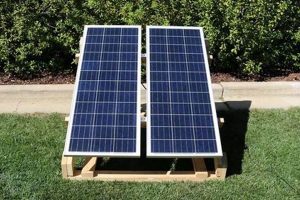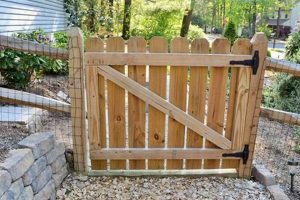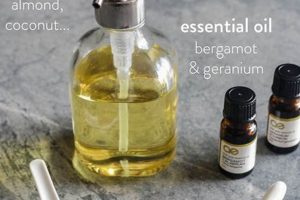Substances created from readily available household items intended to stimulate root development in plant cuttings are an alternative to commercially manufactured rooting compounds. These mixtures typically utilize ingredients believed to contain plant hormones or possess antifungal properties to aid in the propagation process. For example, a solution made from willow bark soaked in water is commonly used due to the presence of salicylic acid, a plant hormone precursor.
The utilization of these homemade solutions can offer a cost-effective and environmentally conscious approach to plant propagation. This method allows gardeners and horticulturalists to propagate plants without relying on synthetic chemicals. Historically, practitioners have experimented with various organic materials to encourage root growth, reflecting a long-standing interest in sustainable gardening practices and a desire to understand the natural processes that govern plant development.
The following sections will delve into specific recipes, application methods, and considerations for effective utilization, including potential benefits, limitations, and appropriate plant species for which these solutions are most effective.
Guidance on Homemade Rooting Solutions
The subsequent points offer practical advice to enhance the effectiveness of self-prepared rooting stimulants. Attention to detail throughout the process contributes to successful plant propagation.
Tip 1: Ingredient Selection: Prioritize fresh, high-quality ingredients. The efficacy of homemade solutions depends on the concentration of active compounds present in the source materials. For instance, using newly harvested willow branches will likely yield a more potent solution than using older, dried materials.
Tip 2: Preparation Method: Adhere precisely to recommended ratios and methods. Overly concentrated solutions can inhibit root development, while diluted solutions may prove ineffective. For example, when creating a honey-based solution, use pure, raw honey at the recommended dilution to minimize the risk of fungal growth.
Tip 3: Cutting Preparation: Employ sterile cutting tools to prevent disease transmission. Furthermore, make clean, angled cuts on the plant material to maximize the surface area exposed to the rooting solution. Remove any lower leaves that would be submerged in the solution to prevent rotting.
Tip 4: Application Technique: Ensure the base of the cutting is consistently in contact with the solution during the rooting process. Cuttings can be placed in a vessel containing the solution or dipped briefly before planting in a suitable rooting medium. Avoid prolonged submersion of the foliage.
Tip 5: Environmental Control: Provide optimal environmental conditions for root development. Maintain consistent humidity and moderate temperatures. A propagation chamber or plastic covering can help retain moisture. Avoid direct sunlight, which can scorch the cuttings.
Tip 6: Observation and Adjustment: Regularly monitor cuttings for signs of root development or fungal infection. If fungal growth appears, gently clean the cuttings and replace the solution with a fresh batch. Adjust environmental conditions as needed.
Tip 7: Rooting Medium Selection: Use a well-draining rooting medium such as perlite, vermiculite, or a mixture of peat moss and sand. This provides adequate aeration and prevents waterlogging, which can inhibit root development.
Consistent application of these practices maximizes the potential for successful root initiation using accessible materials.
The following section offers a summary and considerations for the information presented.
1. Ingredient Sourcing
The selection of components directly influences the efficacy of homemade plant propagation stimulants. The origin and preparation of these components impact the concentration of growth-promoting substances present, subsequently affecting root development.
- Plant Hormones and Precursors
Certain plant tissues, such as willow bark and aloe vera, contain natural hormones or precursors. Willow bark possesses salicylic acid, a precursor to plant hormones, which stimulates root growth. Aloe vera contains enzymes and amino acids believed to facilitate root development. Sourcing these materials locally and ensuring freshness maximizes the concentration of these beneficial compounds.
- Antimicrobial Properties
Some ingredients, such as honey and cinnamon, possess antimicrobial properties that protect cuttings from fungal infections. Raw, unfiltered honey contains enzymes and compounds that inhibit the growth of certain pathogens. Cinnamon acts as a natural fungicide, preventing fungal diseases that can hinder root formation. Selecting high-quality, unadulterated sources ensures optimal antimicrobial activity.
- Nutrient Availability
While not directly hormonal, ingredients like compost tea or seaweed extract provide essential nutrients that support root development. Compost tea contains beneficial microorganisms and readily available nutrients that promote healthy plant growth. Seaweed extract is rich in trace minerals and growth-stimulating compounds that enhance root formation. Sourcing these materials from reputable suppliers ensures consistent nutrient content.
- Water Quality
The water used to prepare and dilute solutions influences the overall effectiveness. Chlorinated tap water can inhibit root growth due to its antimicrobial properties. Using distilled, rainwater, or non-chlorinated water minimizes potential interference with root development. Maintaining water purity enhances the overall efficacy of the solution.
The careful selection of each ingredient is essential for creating potent homemade solutions. Understanding the specific properties of each component and sourcing them from reliable sources ensures optimal results in plant propagation.
2. Solution Concentration
Solution concentration is a critical determinant of success when employing homemade plant propagation stimulants. An improperly balanced solution can inhibit root development, undermine the intended benefits, or even harm the plant cutting.
- Hormone Mimic Potency
Homemade solutions often rely on ingredients that mimic or contain plant hormones. An overly concentrated solution can introduce excessive amounts of these compounds, leading to toxicity and hindering root formation. Conversely, a diluted solution may lack the necessary stimulus to initiate root development. Accurate measurements are essential to achieve the correct balance, maximizing the potential benefit without causing harm.
- Antimicrobial Balance
Many homemade recipes incorporate ingredients with antimicrobial proper
ties to prevent fungal infections. However, an excessively concentrated solution can disrupt the natural microbial balance around the cutting, potentially inhibiting beneficial microorganisms essential for root development. A properly balanced solution provides sufficient protection against harmful pathogens without compromising the beneficial microbial activity. - Osmotic Pressure Effects
The concentration of solutes in the rooting solution can influence osmotic pressure, which affects the movement of water and nutrients into the cutting. An overly concentrated solution can create a hypertonic environment, drawing water out of the cutting and causing dehydration. A diluted solution can create a hypotonic environment, potentially leading to waterlogging and cell damage. Maintaining an appropriate concentration ensures optimal water and nutrient uptake.
- pH Level Impact
The concentration of certain ingredients can affect the pH of the solution, which in turn influences nutrient availability and root development. An excessively acidic or alkaline solution can inhibit root growth and nutrient absorption. Monitoring and adjusting pH levels as needed ensures optimal conditions for root development. A neutral or slightly acidic pH is generally preferred for most plant species.
Precise control over solution concentration is therefore essential for maximizing the efficacy of homemade plant propagation stimulants. Inadequate concentration can render the solution ineffective, while excessive concentration can be detrimental to cutting health and root formation. Achieving the correct balance ensures optimal stimulation of root development without causing harm.
3. Cutting Sterilization
The practice of cutting sterilization holds paramount importance when utilizing homemade plant propagation stimulants. Contamination from pathogens can severely impede root development, negating any potential benefits offered by the chosen solution. The establishment of aseptic conditions is critical for successful propagation.
- Prevention of Pathogen Introduction
Sterilizing cutting tools and plant material surfaces minimizes the risk of introducing harmful bacteria, fungi, or viruses to the propagation environment. These pathogens can cause rot, decay, or other diseases that prevent root formation. For example, dipping cutting tools in a diluted bleach solution or isopropyl alcohol effectively eliminates surface contaminants, preventing their transfer to the plant material.
- Minimization of Cross-Contamination
Unsterilized cutting tools can act as vectors, transferring pathogens from one plant to another. This cross-contamination can be particularly problematic when propagating multiple plant species simultaneously. Sterilizing tools between each cutting minimizes the spread of disease and ensures that each cutting has the best chance of developing healthy roots. Examples include wiping tools with disinfectant wipes or flame-sterilizing them briefly.
- Enhancement of Rooting Solution Effectiveness
A sterile environment allows the homemade rooting solution to work more effectively. Without the competition from harmful microorganisms, the plant can more efficiently absorb the growth-promoting compounds present in the solution. For instance, a honey-based solution will be less susceptible to fungal contamination if the cutting is sterilized beforehand, allowing its antimicrobial properties to function optimally.
- Reduction of Plant Stress
Pathogens introduce stress to plant cuttings, diverting energy away from root development and toward defense mechanisms. A sterile environment reduces this stress, allowing the plant to focus its resources on root formation. Examples of reducing plant stress include using a sterile rooting medium and providing optimal environmental conditions, such as adequate humidity and temperature.
Effective cutting sterilization, therefore, is a critical prerequisite for successful plant propagation utilizing accessible solutions. By minimizing the risk of contamination and promoting a healthy rooting environment, sterilization significantly enhances the chances of successful root initiation and subsequent plant growth.
4. Environmental Control
Environmental control constitutes a pivotal aspect of successful plant propagation, particularly when employing homemade rooting solutions. The external conditions surrounding the cutting directly influence its ability to initiate root development and resist pathogens. Precise management of these factors can significantly enhance the effectiveness of diy rooting hormone applications.
- Temperature Regulation
Maintaining a consistent and appropriate temperature range is essential for optimal root formation. Cuttings generally root best within a temperature range of 65-75F (18-24C). Temperatures outside this range can slow down or inhibit root development. For example, a heat mat placed under the propagation tray can provide consistent bottom heat, encouraging faster root growth. Conversely, excessive heat can lead to dehydration and death of the cutting. Diy rooting hormone solutions will be more effective when temperature requirements are met, as the plant can focus its energy on root production rather than stress mitigation.
- Humidity Management
High humidity levels reduce water loss from the cutting through transpiration, preventing dehydration and promoting root formation. A humidity dome or plastic bag placed over the cuttings can create a humid microclimate. Insufficient humidity can lead to wilting and death of the cutting, regardless of the rooting solution employed. For example, misting the cuttings regularly can help maintain adequate humidity levels. The benefits of diy rooting hormone are amplified in a humid environment, as the solution can be absorbed more effectively and the cutting is less stressed by water loss.
- Light Exposure
Adequate light is necessary for photosynthesis, which provides the energy required for root development. However, direct sunlight can scorch the cuttings, causing damage and hindering root formation. Indirect or filtered light is generally preferred. For example, placing the cuttings near a window with sheer curtains provides sufficient light without the risk of sunburn. Optimal light exposure allows the cutting to produce the energy necessary for root growth, maximizing the effectiveness of diy rooting hormone solutions.
- Air Circulation
While high humidity is beneficial, stagnant air can promote the growth of fungal pathogens. Gentle air circulation prevents the buildup of excess moisture and reduces the risk of disease. A small fan placed near the propagation area can provide adequate air circulation without drying out the cuttings. Proper air circulation creates a healthier environment for root development, allowing the benefits of diy rooting hormone to be fully realized without interference from fungal infections.
In summary, careful control over temperature, humidity, light, and air circulation is paramount to successful plant propagation with diy rooting hormone. These environmental factors create an optimal environment for root initiation and growth, maximizing the effectiveness of the ch
osen rooting solution. Without proper environmental control, the potential benefits of diy rooting hormone can be significantly diminished, leading to reduced success rates.
5. Application Technique
The efficacy of any rooting stimulant, including homemade formulations, is intrinsically linked to the method of application. Correct application maximizes contact between the cutting and the active compounds, facilitating absorption and promoting root initiation. Suboptimal application techniques can render even the most potent solutions ineffective.
- Cutting Immersion Duration
The length of time a cutting is submerged in a rooting solution influences the uptake of active compounds. Prolonged immersion can lead to waterlogging and tissue damage, hindering root development. Insufficient immersion may result in inadequate absorption. A controlled dipping duration, typically ranging from a few seconds to several minutes depending on the ingredient and plant species, optimizes compound absorption without causing harm. For instance, softwood cuttings generally require shorter immersion times compared to hardwood cuttings.
- Solution Delivery Method
The manner in which the solution is delivered impacts its effectiveness. Dipping the cutting directly into the solution ensures uniform coverage. Alternatively, some propagate cuttings directly in the solution, but this can increase the risk of stem rot. A further approach includes foliar spraying for select plants, though its generally less effective for root stimulation than direct contact methods. Each method necessitates careful consideration based on the cutting type and solution properties.
- Wound Management at the Cut Site
The condition of the cut site significantly affects solution absorption. Clean, angled cuts promote optimal uptake. Some practitioners advocate for lightly scoring the base of the cutting to increase surface area and encourage callus formation. However, excessive wounding can create entry points for pathogens. Careful wound management prepares the cutting for optimal solution absorption and root development.
- Post-Application Environment
The environment following solution application directly influences rooting success. Maintaining high humidity prevents desiccation, while adequate air circulation minimizes fungal growth. Consistent temperatures within the optimal range promote root development. Immediately after treating the plant with a solution to promote root growth, these are crucial considerations.
These considerations underscore the importance of meticulous application techniques when utilizing diy rooting hormone. Effective application ensures maximal uptake of active compounds, minimizes the risk of adverse effects, and optimizes the environment for successful root initiation, thereby increasing the likelihood of successful plant propagation.
Frequently Asked Questions
This section addresses common inquiries regarding the use of readily available materials to stimulate root growth in plant cuttings. The information provided aims to clarify misconceptions and offer guidance on practical application.
Question 1: What constitutes a suitable alternative to commercially produced rooting compounds?
Substances derived from household ingredients, such as willow bark extract, honey solutions, or cinnamon powder, serve as accessible alternatives. These materials are believed to contain plant hormones or possess antifungal properties conducive to root development.
Question 2: Are plant propagation stimulants created using household products as effective as commercial products?
The effectiveness of these solutions can vary based on ingredient concentration, preparation method, and plant species. While some homemade options demonstrate comparable results to commercial products under controlled conditions, rigorous scientific validation remains limited. Variability in plant response is typical.
Question 3: What plant types respond most favorably to propagation stimulants made from common household goods?
Softwood cuttings from herbaceous plants and some semi-hardwood cuttings tend to exhibit the most favorable response. Hardwood cuttings typically require more potent stimuli, often necessitating commercial-grade rooting hormones. Experimentation is recommended to determine compatibility with specific plant species.
Question 4: What are the potential risks associated with using diy rooting hormone?
Improper preparation or excessive concentration can cause phytotoxicity, inhibiting root development or damaging plant tissues. Contamination of the solution with pathogens can also lead to disease transmission. Caution is advised to adhere to recommended guidelines and maintain sterile conditions.
Question 5: Can diy rooting hormone be stored for extended periods?
Shelf life varies depending on the ingredients used. Solutions containing organic matter, such as honey or willow bark extract, are prone to degradation and microbial contamination. Refrigeration can extend shelf life, but fresh preparation is generally recommended for optimal efficacy.
Question 6: Is it necessary to adjust the solution based on the plant species being propagated?
Different plant species exhibit varying sensitivities to growth stimulants. Dilution of the solution may be necessary for delicate cuttings, while more robust species may tolerate higher concentrations. Careful observation of plant response is crucial for adjusting application techniques.
In summary, diy rooting hormone provides a potentially viable, cost-effective alternative to commercial rooting compounds, provided meticulous preparation and appropriate application techniques are employed. Awareness of the potential risks and limitations is essential for successful plant propagation.
The subsequent segment provides guidance on ingredient selection and sourcing for optimized results.
In Conclusion
This exploration of diy rooting hormone underscores its potential as a cost-effective and accessible method for plant propagation. The efficacy of these homemade solutions hinges on careful ingredient selection, precise solution concentration, meticulous sterilization practices, stringent environmental control, and skillful application techniques. Each of these factors contributes significantly to the success or failure of root initiation in plant cuttings.
While commercial rooting hormones offer consistent formulations and scientifically validated results, diy rooting hormone provides a sustainable alternative for informed practitioners. Future research into the specific compounds present in common household ingredients and their effects on various plant species could further enhance the reliability and effectiveness of these homemade solutions, promoting wider adoption and contributing to more sustainable horticultural practices.







